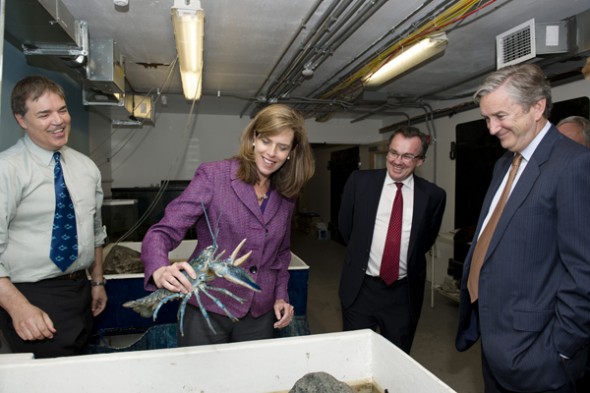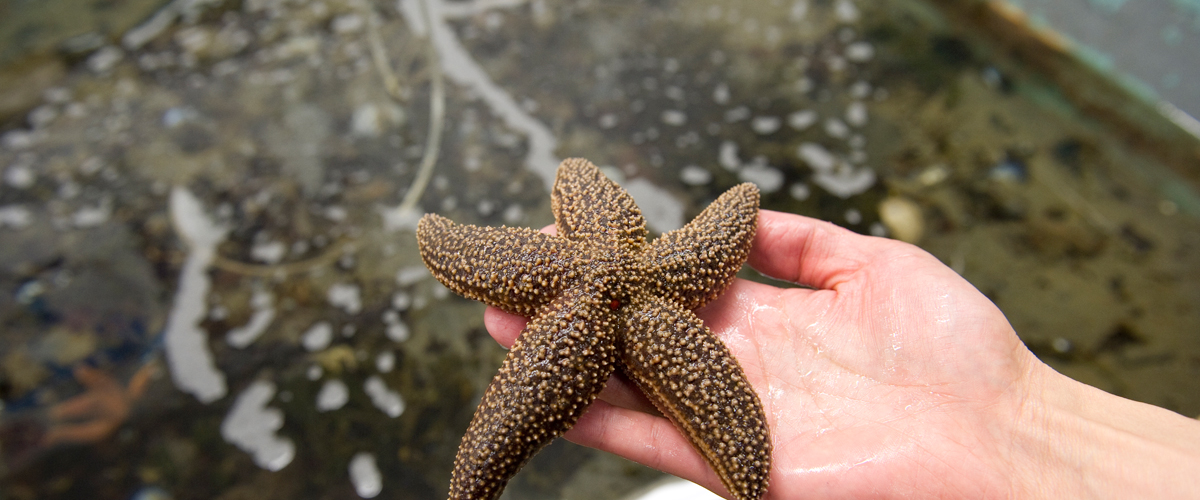by Angela Herring
The squirming claws of a blue lobster did not deter U.S. Reps. John Tierney and Katherine Clark from getting their hands dirty—and soaked—as they eagerly examined the rare species on Wednesday at Northeastern’s Marine Science Center in Nahant, Massachusetts.
Tierney and Clark, along with staff members from U.S. Sens. Ed Markey and Elizabeth Warren’s offices, visited the facility to learn more about the range of urban coastal sustainability research taking place on site and to identify opportunities to work together to secure more science research funding.
Murray J. Gibson, dean of the College of Science and the event’s host, said the majority of marine labs around the country were deliberately built in remote areas minimally affected by human development. “But it turns out the impacts of man on cities by the sea have become a major issue in their own right and they haven’t been studied extensively,” he said.
The Marine Science Center, on the other hand, exists in a unique sweet spot set only three miles as the crow flies from Boston. Researchers here are leveraging this advantage by looking at coastal marine species and their human neighbors as an integrated whole rather than separate entities.
For example, assistant professor Jon Grabowski examines not only the basic ecology of the fisheries he studies, but also the industries that rely on them and the economic values of the services they provide. Professor Brian Helmuth focuses on coastal adaptation to climate change and predicting where trouble spots are likely to emerge. He then uses that information to proactively inform coastal planners, resource managers, and other decision makers.
Over the past several years, the university has invested $15 million to improve the research facility and has added even more value in the way of faculty appointments, all in the name of furthering urban coastal sustainability.
“To be here at the Marine Science Center and look at sustainability from an urban perspective is really unique—and so needed,” said Clark, who is a member of both the House Natural Resources Committee and the Committee on Science, Space, and Technology. She added that it’s essential that politicians discuss climate change and develop partnerships with the scientists and students like those at Northeastern who are the forefront of discovering solutions “to the mess we’re handing them.”
These discussions and partnerships rely on good research, which relies on government investment, noted Tierney, who represents the state’s North Shore where the Marine Science Center is located. “If it wasn’t for state governments making an investment in education, innovation, science—we wouldn’t be doing much,” Tierney said.
During Wednesday’s visit, the delegation first took a tour of the facility, which included a visit to the hands-on touch pool and an up-close look at its the state-of-the-art research labs. Then, the delegation sat for a roundtable discussion with professors Brian Helmuth and Mark Patterson, assistant professors Jon Grabowski and Randall Hughes, and a handful of post-doctoral researchers and graduate students.
The attendees agreed that more must be done to expand the federal budget for science and to level the funding playing field for research institutions. Tierney and Clark expressed their commitment to help make that happen. “There’s no reason we should be holding back,” Tierney said.

